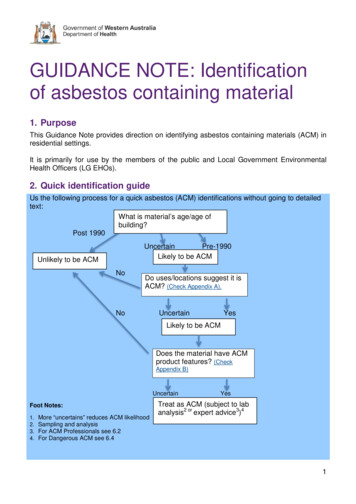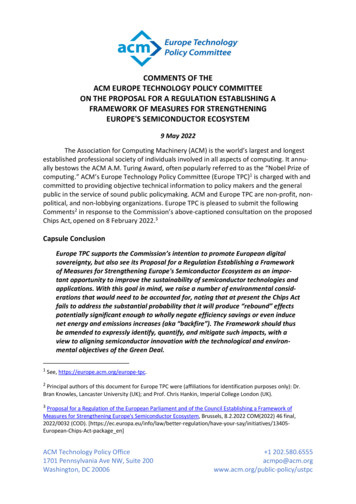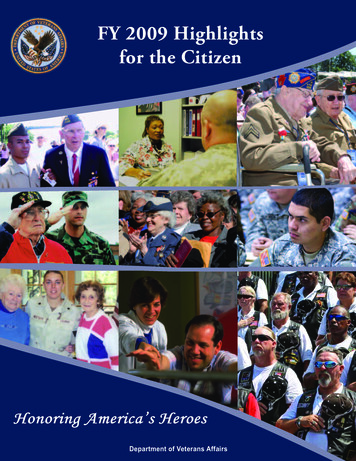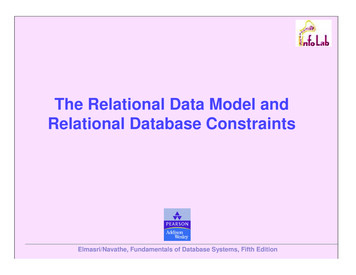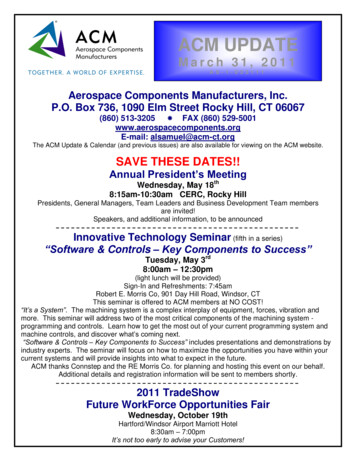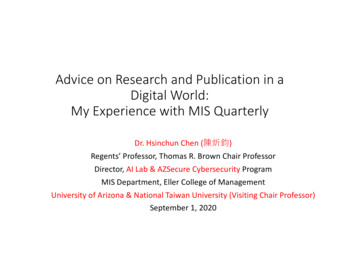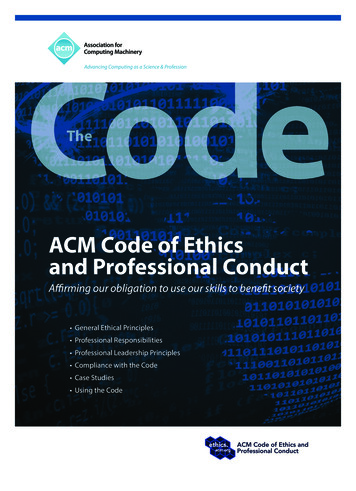
Transcription
ACM Highlights Learning Center tools for professional development: http://learning.acm.org Safari Learning Platform Skillsoft Learning Collections 50,000 trusted technical books, video courses, and O’Reilly conference videosHundreds of learning paths, online learning tools, case studies1,800 Skillsoft courses, virtual labs, test preps, live mentoring for software professionals covering programming,data management, DevOps, cybersecurity, networking, project management, more4,800 30,000 task-based short videos for “just-in-time” learningTraining toward top vendor certifications (CEH, Cisco, CISSP, CompTIA, ITIL, PMI, etc.) 1,200 DRM—free books in CS on the ScienceDirect platform (including Morgan Kaufmann and Syngress titles) Learning Webinars from thought leaders and top practitioners Podcast interviews with innovators, entrepreneurs, and award winnersPopular publications: Flagship Communications of the ACM (CACM) magazine: http://cacm.acm.org/ ACM Queue magazine for practitioners: http://queue.acm.org/ACM Digital Library, the world’s most comprehensive database of computing literature: http://dl.acm.org.International conferences that draw leading experts on a broad spectrum of computing topics:http://www.acm.org/conferences.Prestigious awards, including the ACM A.M. Turing and ACM Prize in Computing: http://awards.acm.orgAnd much more http://www.acm.org.
The History ofSoftware EngineeringGrady BoochIBM Fellow & Chief Scientist for Software EngineeringEmail: gbooch@us.ibm.comTwitter: @grady boochWeb: computingthehumanexperience.comV1.0
Imhotep is considered the first engineer; helived in Egypt around the 27th century BCE,and served as the chancellor to thepharaoh Djoser, architect of the steppyramid, and high priest of the sun god Ra.
In the 19th century BCE, the Code ofHammurabi had this to say: If a buildererect a house or a man and do not make itsconstruction firm, and the house on whichhe built collapse and cause the death of theowner of the house, that builder shall beput to death.
Ismail al-Jazari is another candidate forconsideration as the first engineer; he livedin Turkey around the 12th century CE,during the Islamic Golden Age. Author ofThe Book of Knowledge of IngeniousMechanical Devices, he is also consideredthe father of robotics.
The term systems engineering dates backto Bell Telephone Laboratories in the early1940s, with major applications of systemsengineering during World War II.
Worldwide, engineering is largely anoccupational closure, requiring graduationfrom an accredited college or university, thepassing of a standard examination, andexperience working as an apprentice underother licensed engineers.
The first computers werehuman (and, for the most part,women).A pioneer in Boolean logiccircuits, Stibitz coined the termdigital around 1942.Co-inventor of the FastFourier Transform algorithm,Tukey coined the termsoftware in 1952.
Prompted by the so-called software crisis marked by the rapid rise of computationalpower together with the growing complexityof problems to be addressed - NATO helda Software Engineering Conference in1968 and again in 1969. Bauer proposedthe term software engineering to mean the“establishment and use of soundengineering principles to economicallyobtain software that is reliable and workson real machines efficiently.”
In the August 1966 issue ofCommunications of the ACM, Oettinger hadthis to say: “A concern with the science ofcomputing and information processing,while undeniably of the utmost importanceand an historic root of our organization is,alone, too exclusive. We must recognizeourselves as members ofan engineering profession, be it hardwareengineering or software engineering, aprofession without artificial and irrelevantboundaries like that between ‘scientific’ and‘business’ applications.”
First a developer for SAGE and then thelead developer for the Skylab and Apolloflight software, Hamilton coined the termsoftware engineering around 1963 or 1964while working at the Charles Stark DraperLaboratory at MIT.
“To me programming is morethan an important practical art.It is also a giganticundertaking in the foundationsof knowledge.”“The art of programming is theart of organizing complexity.”“Computer programming is anart, because it appliesaccumulated knowledge to theworld, and especially becauseit produces objects of beauty.”
“Software engineering is often treated as abranch of computer science. This is akin toregarding chemical engineering as abranch of chemistry. We need bothchemists and chemical engineers but theyare very different. Chemists are scientists,chemical engineers are engineers.Software engineering and computerscience have the same relationship.”
ntReliabilityEvolutionPerformanceFunctionality
programming (1842)Boolean algebra (1847)
25
human computing (1896)human computing (1896)
27
process charts (1921)analysis (1921)
29
human computing (1938)punch card methods (1940)
31
relay logic (1937)theoretical computer science(1944)electromechanicalcomputation (1944)machine-independentprogramming (1952)
33
theoretical computerscience (1936)programmable computation(1943)workflow (1943)high order languages (1936)
35
programming (1946) programming (1946) programming (1946) programming (1946) programming (1946)
programming (1948)subroutine (1949)subroutine (1949)programming (1949) programming (1949)
38
imperativeprogramming (1946)flowchart (1947)flowchart (1947)
40
1955operating system (1951)imperativeprogramming (1960)imperativeprogramming (1960)imperativeprogramming (1960)
42
real time computing(1951)program management (1957)time sharing (1959)programming services (1959)
44
project management (1964)modularprogramming/coupling &cohesion/data flow (1968)structured programming(1969)
formal systems (1967)object-orientedprogramming (1967)object-orientedprogramming (1967)formal systems (1969)
47
“Software during the early days of this project was treated like a stepchild and not taken asseriously as other engineering disciplines, such as hardware engineering; and it wasregarded as an art and as magic, not a science. I had always believed that both art andscience were involved in its creation, but at that time most thought otherwise. Knowingthis, I fought to bring the software legitimacy so that it (and those building it) would begiven its due respect and thus I began to use the term ‘software engineering’ to distinguishit from hardware and other kinds of engineering; yet, treat each type of engineering as partof the overall systems engineering process. When I first started using this phrase, it wasconsidered to be quite amusing. It was an ongoing joke for a long time. They liked to kidme about my radical ideas. Software eventually and necessarily gained the same respectas any other on-7d550c73d3fa
49
process ormation hiding(1972)abstract data types(1974)entity-relationshipmodeling (1976)
SADT (1969)structured design(1972)structured design(1972)Jackson structuredstructured analysisdesign (1975) and system specification(1978)
software inspection (1976)functional programming(1977)distributed computing (1978)
1997Booch method (1986)OMT (1990)Objectory (1990)
object-orientedanalysis (1988)structured analysis (1989)Responsibilitydriven design (1989)object-orientedanalysis and design (1990)
software engineeringeconomics (1981)spiral model (1988)empirical softwareengineering (1986)component based clean room softwaresoftware engineering engineering (1987)(1986)capability maturitymodel (1988)
Structured SystemsAnalysis and DesignMethodologies (1981)Defense SystemsSoftware Development(1985)1984Information engineering/CASE(1981)1993Zachman framework (1987)
Literate programming (1983)free software (1983)visual programming (1991)
SCRUM (1995)extreme programming (1996)refactoring (1999)Rational Unified Process(2000)
1993Design patterns (1994)Rational UnifiedProcess/software architecture(1995)software architecture (1996)
configuration management(1997)open source (1997)outsourcing (2001)
63
2001git (2005)organizational patterns(2005)computationalthinking (2006)Stackoverflow (2007)clean code (2008)
devops (2008)devops (2008)
platform computing (2000)platform computing (2006)
69
PhysicsAlgorithmArchitectureOrganizationComputer scienceSoftware engineeringEconomicsHuman
The Software Engineering Body ofKnowledge was first released in 2004 (itscurrent version was published in 2014), andaddresses Software requirements Software design Software construction Software testing Software maintenance Software configuration management Software engineering management Software engineering process Software engineering models andmethods
The Systems Engineering Body ofKnowledge is an effort by the InternationalCouncil of Systems Engineering (INCOSE),the Systems Engineering Research Center(SERC), and the IEEE Computer Society tocodify the best practices of systemsengineering.
MathematicalSymbolicPersonalDistributed &ConnectedImaginedRealities
MathematicalSymbolicPersonalDistributed &ConnectedImaginedRealitiesFundamentalsManaging complexityHuman/computer interactionManaging scaleEthical and moral issues
76
The fundamentals always apply: Crisp abstractions Clear separation of concerns Balanced distribution of responsibilities SimplicityGrow a system through the iterative,incremental, and continuous release of itsexecutable architecture.
Still, there is work to be done: Orchestrating hybrid symbolic,connectionist, and quantum models ofcomputation The architectural pendulum The edge/cloud pendulum Scale, in the presence of untrustedcomponents, legacy of considerableinertia, and the general public
Software is the invisible writing that whispersthe stories of possibility to our hardware
and you are the storytellers.
Grady BoochIBM Fellow & Chief Scientist for Software EngineeringEmail: gbooch@us.ibm.comTwitter: @grady boochWeb: computingthehumanexperience.com
ACM: The Learning Continues Questions/comments about this webcast? learning@acm.org ACM’s Discourse Page: http://on.acm.org ACM Learning Webinars (on-demand archive): http://webinar.acm.org ACM Learning Center: http://learning.acm.org ACM Queue: http://queue.acm.org ACM AiDecentralized Conference: https://www.aidecentralized.com/
Training toward top vendor certifications (CEH, Cisco, CISSP, CompTIA, ITIL, PMI, etc.) 1,200 DRM—free books in CS on the ScienceDirect platform (including Morgan Kaufmann and Syngress titles) Learning Webinars from thought leaders and top practitioners . in Turkey around the 12 th century CE, during the Islamic Golden Age .

